by Holly Case and Lexi Lerner
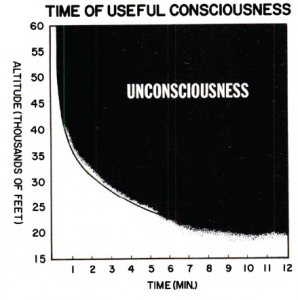
What follows is part of a collaborative project between a historian and a student of medicine called “The Temperature of Our Time.” In forming diagnoses, historians and doctors gather what Carlo Ginzburg has called “small insights”—clues drawn from “concrete experience”—to expose the invisible: a forensic assessment of condition, the origins of an idiopathic illness, the trajectory of an idea through time. Taking the temperature of our time means reading vital signs and symptoms around a fixed theme or metaphor—in this case, the oxygen mask—to reveal how our everyday, recorded interactions can acquire extraordinary historical momentum.
“Among the various exploits, vital or destructive, which oxygen can perform, we varnish makers are interested above all in its capacity to react with certain small molecules such as those of certain oils, and of creating links between them, transforming them into a compact and therefore solid network.” —Primo Levi, The Periodic Table (1975)
“[A]t 40,000 ft, people have as little as 18 seconds of ‘useful consciousness’ time if they are starved of oxygen. […] [T]he risks of hypoxia–oxygen starvation–are all the greater as people may not realise they are suffering until they can no longer breathe and fall unconscious …” —Lizzie Porter, “What happens when a plane loses cabin pressure?” The Telegraph (Feb. 3, 2016)
“‘Put on your own mask before helping someone else.’ […] I believe this is a metaphor for life.” —Paul Dodd, “The Metaphor of the Airplane Oxygen Mask,” Modern Enlightenment [blog] (May 16, 2015)
***
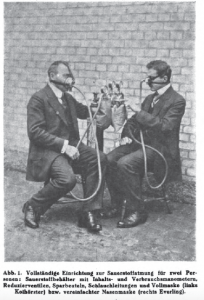
“Before the oxygen apparatus was used I used to suffer a great deal from flying at high altitudes. […] I used to get this palpitation of the heart and headache when I would fly over 16,000 feet; I would also feel ‘rotten and done up,’ […]” Air Service Medical, War Department, Air Service Division of Military Aeronautics (1919)
“The sentence ‘Mary had a little lamb’ was dictated to the subject of a pressure chamber demonstration of the deterioration of writing skill at a hypoxia-producing altitude.”
 “A great danger of hypoxia is that it is impossible to predict exactly when or where hypoxia will occur in flight or how it will manifest itself. The symptoms are unique with each individual and will vary within the individual from time to time. Generally, the onset of hypoxia is characterized by sensations of sleepiness, fatigue, headache, blurred vision, confused mental judgement and loss of muscular control. Sometimes hypoxia will cause dizziness or nausea, giddiness or a feeling of extreme well-being. It can induce all the moods of intoxication.” “Mary Had a Little Lamp,” Approach, The Naval Aviation Safety Review (June 1962)
“A great danger of hypoxia is that it is impossible to predict exactly when or where hypoxia will occur in flight or how it will manifest itself. The symptoms are unique with each individual and will vary within the individual from time to time. Generally, the onset of hypoxia is characterized by sensations of sleepiness, fatigue, headache, blurred vision, confused mental judgement and loss of muscular control. Sometimes hypoxia will cause dizziness or nausea, giddiness or a feeling of extreme well-being. It can induce all the moods of intoxication.” “Mary Had a Little Lamp,” Approach, The Naval Aviation Safety Review (June 1962)
“Destin Sandlin, an engineer who created the Smarter Every Day educational video series on Youtube, enters a hyperbaric chamber, where atmospheric pressure can be controlled. The chamber simulates the experience of flying at 25,000ft. He starts off on oxygen but then removes his mask to feel the effects of hypoxia. After he starts to feel affected, Destin delays going back on oxygen to demonstrate the physiological impact this has. This is shown through the use of a simple children’s game which involves putting different shaped blocks into the corresponding shaped holes. At first Destin finds this task easy, unsurprisingly. But after just three minutes and 45 seconds, he finds it much harder to do – his coordination is severely affected, and he forgets what the different shapes are called, referring to a cross as a square. He also starts to shake and is informed that if his oxygen saturation level, which is being carefully monitored, drops below 60, he could die at any moment. Destin is told he needs to get back on oxygen or he’s going to die. All he needs to do is put his mask back on and flip the switch. But by this stage the effects of hypoxia mean he is incapable of completing this simple task by himself. Someone puts his oxygen mask back on, and within a short time he is able to complete the shape box game again with no issues.” Helen Coffey, “Hypoxia Definition—why adults SHOULD do their oxygen mask BEFORE a child’s on a flight,” Express (Jan. 24, 2017)
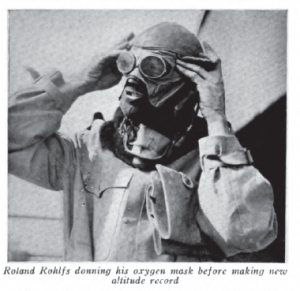
“I took off at 1:45 p.m., Wednesday, September 18, 1918, and made a steady circular climb […] When I reached 25,000 feet I noticed the sun growing very dim, I could hardly hear my motor run, and I felt very hungry […] I went on talking to myself, and this I felt was a good sign to begin taking oxygen, and I did. I was then over 25,000 feet and as soon as I started to inhale the oxygen the sun grew bright again, my motor began to exhaust so loud that it seemed something must be wrong with it. I was no longer hungry and the day seemed to be a most beautiful one. I felt like singing with sheer joy […] I kept at it until my oxygen gave out […] I remember that the horizon seemed to be very much out of place, but I felt that I was flying correctly and that I was right and the horizon was wrong. About this time the motor quit. I was out of gasoline […] I landed O.K., and broke the tip of my propeller, which was standing vertical, when I rolled into a depression on the ground.” Capt. R. W. Schroeder, “Statement by an Officer of a Testing Squadron Regarding Altitude Record Which was Established September 18, 1918,” Air Service Medical (1919)
“Appendix O. APRIL 18, 1969. Office of the General Counsel, Rules Docket Section, Federal Aviation Administration, Washington, D.C. […] GENTLEMEN : This is in reply to the subject Notice of Proposed Rule Making to require that smoke hoods be carried on all airplanes operated under Part 121 of the Federal Aviation Regulations. […] Though the dangers of hypoxia are pointed out, there has been no clear-cut or reliable way to recognize hypoxia in one’s self—particularly, when considering that the chief characteristic of hypoxia is the well-being feeling associated with euphoria. This situation would be compounded by the concomitant onset of CO2 narcosis in the smoke hood. Therefore, we fail to see how training could be conducted on the symptoms of suffocation, either for one’s self or being able to observe suffocation in other people. This would be most difficult if not impossible considering that the passengers would be covered with a smoke hood. The first detectable visual sign of such suffocation would probably be the person collapsing.” US Congress, House Committee on Public Works and Transportation, Subcommittee on Investigations and Review, “Aviation Safety: Hearings Before the Subcommittee On Investigations And Review of the Committee On Public Works And Transportation, 94th Congress” (1976)
“An alert, knowledgeable person has a much better chance of surviving any life- or injury- threatening situation. Therefore, the FAA requires a passenger information system which includes oral briefings and information cards. It would be desirable to have every airline passenger highly motivated; however, motivating people, even when their own personal safety is involved, is not easy. One way to increase motivation is to make the presentations as interesting as possible. This advisory circular encourages the operators to be innovative in their approach. […] (9) Oxygen Masks. If the flight involves operation above 12,000 feet MSL, passengers should be briefed before takeoff on both normal and emergency use of oxygen. This should include instructions about locating, donning, and adjusting the equipment; prohibition against smoking; and any action which might be necessary to start the flow of oxygen. Passengers should also be informed that they should don their own oxygen mask before assisting children with their masks.” US Department of Transportation, Federal Aviation Administration, Advisory Circular 135-12 (Oct. 1984)
“1. ORAL BRIEFINGS. […] Flight attendants giving the demonstrations should coordinate them with the applicable information given in the oral briefing, be animated, and make eye contact with as many passengers as possible.” US Department of Transportation, Federal Aviation Administration, Advisory Circular 121-24B (Feb. 1999)
“Grim_Darkwatch 36 points · 3 years ago
When I was a kid in the 90’s, the flight attendants used me as an example of how to wear your mask properly. It wasn’t very exciting […]” Grim_Darkwatch, Re: clark848, “Has anyone ever used the oxygen masks in an airplane? Explain your experience,” r/AskReddit, Reddit (archived)
“Safety procedures noted in the briefing document stress recognising the symptoms of hypoxia–nausea, headaches, and euphoria among them–and donning the nearest oxygen mask and holding on to the nearest fixed item. Alarmingly, the note added; ‘In one cabin decompression event, a cabin crewmember was saved from ejection out of the aircraft, because a passenger was holding on to the cabin crewmember’s ankle.'” Porter, “What happens…?” (Feb. 3, 2016)
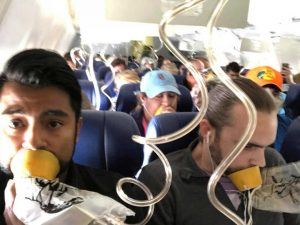
“[D]uring an extremely stressful event it can be hard to remember even the most basic instructions. A photo taken by one of those on board, and subsequently shared on Twitter, shows passengers wearing their oxygen mask incorrectly […] [M]ost of us have heard the spiel so many times we could probably recite it by heart. ‘In the unlikely event of a sudden loss of cabin pressure, oxygen masks will drop down from the panel above your head… Secure your own mask before helping others… Cover your nose and mouth.’ More likely, perhaps, is that passengers on the Southwest flight simply panicked. We are all capable of freezing in the face of danger and failing to follow instructions.” Oliver Smith, “The truth about oxygen masks on planes – what can the Southwest incident teach us?” The Telegraph (April 19, 2018)
“MOGADISHU, Somalia (AP) — An explosion that blew a hole in a jetliner shortly after takeoff and left one man missing was believed to have been caused by a bomb, the pilot said Wednesday […] Capt. Vlatko Vodopivec, the pilot, said he and others were told the explosion was caused by a bomb. ‘It was my first bomb; I hope it will be the last,’ Vodopivec told the AP by phone from Mogadishu. […] Cellphone video taken during the flight showed passengers, some wearing oxygen masks, sitting toward the back of the jet, with empty seats in the front of the cabin near the hole in the fuselage. A loud sound of rushing air could be heard on the video, which was shot by Awale Kullane, Somalia’s deputy ambassador to the United Nations. The passengers bunched in the back appeared calm. A child wearing an oxygen mask sat quietly, partially covered by a blanket. Near the hole, oxygen masks dangled and swayed from overhead compartments.” Abdi Guled, “Pilot recounts blast on jet, emergency return to Mogadishu,” AP (Feb. 3, 2016)
“Should a plane’s pressurisation systems be in order, a drop in the cabin pressure that makes the plane think it is above 14,000 ft will see the oxygen masks fall from panels above passengers’ heads – in a scene known to cabin crew as the ‘rubber jungle.'” Porter, “What happens…?” (Feb. 3, 2016)
“SPUDRacer 123 points · 3 years ago
Flying from Denver to Steamboat Springs in an old turboprop plane (a long time ago), we hit incredible turbulence before landing. The pilots dropped the O2 masks and told everyone that we were fine, that they had flown through worse, and they were altering course to find smoother air. When we landed, I asked the captain why the O2 and he said that he did that and he said that it gave the passengers something to do. It worked, we really did calm down afterwards.” SPUDRacer, Re: clark848, “Has anyone ever…,” r/AskReddit, Reddit
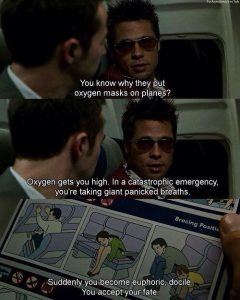 “You know why they put oxygen masks on planes? Oxygen gets you high. In a catastrophic emergency, you’re taking giant panicked breaths. Suddenly you become euphoric, docile. You accept your fate. It’s all right here [points at an emergency instruction manual on a plane]. Emergency water landing – 600 miles an hour. Blank faces, calm as Hindu cows.” Brad Pitt as the character Tyler Durden in the film Fight Club (script by Jim Uhls, 1998, based on a novel by Chuck Palahniuk)
“You know why they put oxygen masks on planes? Oxygen gets you high. In a catastrophic emergency, you’re taking giant panicked breaths. Suddenly you become euphoric, docile. You accept your fate. It’s all right here [points at an emergency instruction manual on a plane]. Emergency water landing – 600 miles an hour. Blank faces, calm as Hindu cows.” Brad Pitt as the character Tyler Durden in the film Fight Club (script by Jim Uhls, 1998, based on a novel by Chuck Palahniuk)
“That claim is that Zaharie, a veteran pilot, depressurized the plane after turning off its transponder. Shortly afterward, everyone else on the plane was knocked out by oxygen deprivation, unwittingly being ferried to their deaths. The reason for Zaharie’s supposed suicidal ideation? There were rumors that his marriage was ending and his wife was about to leave him. ‘He was killing himself,’ Larry Vance, a veteran aircraft investigator from Canada, said on the ‘60 Minutes’ panel. ‘Unfortunately, he was killing everyone else on board. And he did it deliberately.'” Cleve R. Wootson, “Investigators insist MH370 crash was an accident, not a mass murder-suicide by the pilot,” The Washington Post (May 23, 2018)
“Liking yourself and being able to spend enjoyable time by yourself I believe is the foundation of being able to be friends with other people. A simple analogy is when they say ‘fit your own oxygen mask first’ in the aeroplane safety briefing. Why is that? Because you can’t help anyone else if you’re dead.” Don Charisma, “Making Friends with Yourself,” doncharisma.org [blog] (May 10, 2014)
“You will be no help to anyone if your relationship with God is not right. […] ‘The oxygen mask is right in front of you Timothy,’ Paul says. ‘You’ve known it since you were a kid. The Scriptures lead to salvation through faith in Christ Jesus. You can’t help anyone until you put on the mask and breathe in God’s Spirit through the Bible.'” Rev. Dr. Douglas C. Hoglund, “Put Your Oxygen Mask On First,” [sermon, The Woodside Church, Yardley, Penn.] (Oct. 16, 2016)
“As it is with the flight attendants, so it is with us as preachers. We must give clear and persuasive instructions about how to be saved.” Ron Forseth, “How to Preach without Cabin Pressure,” Sermon Central (Oct. 26, 2016)
“Good morning Ladies and Gentlemen. Welcome aboard UM Hillel Flight 1836 bound for real life. Our captain, God, has informed us that our flying time will be approximately 120 years give or take a few. At this time, we want to review with you some of the safety features of our aircraft.” Rabbi Lyle S. Rothman, “Self Care,” [Yom Kippur Morning Sermon, University of Miami Hillel] (Oct. 12, 2016)
“Fasten Your Own Oxygen Mask First! […] The lesson we learn from Noach is that when we are embarking on an emergency mission to save the world from a calamity we must make sure that we are strong and up to the mission.” Heschel Greenberg, Light from the Future: Essays on Parshas Noach (2017)
“The final chapter of the novel—entitled ‘The Sacrifice of Abraham’— promises to resolve the initial scene’s ambiguities. […] In the film, after the President gives Blackie the order to drop his bombs, the scene cuts to a profile shot of Blackie in the cockpit of his jet, wearing an oxygen mask. […] After initiating a countdown, he drops the bomb, and injects himself with his suicide kit. As the poison takes effect and he begins convulsing […] Blackie realizes that […] [he] is both bull and matador, sacrificer and sacrificed, victim and executioner.” Hunter B. Dukes, “The Binding of Abraham: Inverting the Akedah in Fail-Safe and WarGames,” Journal of Religion & Film (2015)
“Rabbi Hillel is famous for having said, ‘If I am not for myself, who will be for me; if I am not for others, what am I? If not now, when?’ Taken in its best light (and not as the recruiting technique for going to war this quote has served), this means we must, as they say on the airplane, ‘put on our own oxygen mask first before helping others.’ I often think of this principle, when I am emphasizing the fundamental physical alignment principle of shins in/thighs out. If you have taken even just a few Anusara classes, you have probably heard the teacher say ‘shins in, thighs out.’ […] When applied with enthusiasm and in the right sequence, ‘shins in/thighs out’ protects our knees and opens the groins, hips, and pelvic floor in a way that gives us greater access to finding the strength of our pelvic floor, low back and abdominal muscles. It is a perfect example of an appropriate personal boundary: it leaves us open and available to receive and observe all that is good, while creating a protective and appropriate boundary from which we can grow safely better to serve.” Elizabeth Goodman, “Shins In/Thighs Out (and Rabbi Hillel),” Rose Garden Yoga [blog] (Jan. 28, 2010)
“The work of NGOs, nonprofits, and Christian think tanks knows no bounds; it’s not like we could ever be finished! But this becomes a dangerous temptation to work incessantly as if we can save the world—as if Jesus was hovering over us, Janet-Jackson-like, asking demandingly, ‘What have you done for me lately?’ But we need to secure our own masks first.” James K. A. Smith, “Secure Your Own Mask First,” Convivium (May 24, 2013)
“Michael Jackson has a message for both the moonshot twenty-something and the complacent Baby Boomer who believes you need to be special to change anything in this world:
‘I’m starting with the man in the mirror
I’m asking him to change his ways
And no message could have been any clearer
If you wanna make the world a better place
Take a look at yourself, and then make a change.’
Change is like an oxygen mask on an airplane – be the change before even thinking about turning to someone else. […] Ask yourself, ‘am I holding myself to the same high standards that I hold the public?’ If you can’t get the man in the mirror to make a change, how’re you going to change anything else?” Spencer McCullough, “This Election Day, Look at the Man in the Mirror,” spence.xyz [blog] (Nov. 8, 2016)
“Michael Jackson’s oxygen chamber has been found lying in a storage warehouse. […] The chamber enables patients to breath in 100 per cent oxygen, rather than the 21 per cent normal concentration in air, which can allow for speedier recovery of damaged tissue.
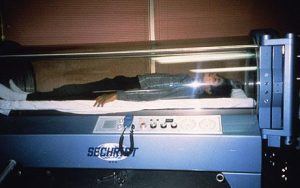
In 1986 he was pictured using it again, apparently sleeping. An American magazine quoted him as saying: ‘I plan to get one immediately. If I treat my body properly I’ll live to at least 150.'” “Michael Jackson’s oxygen chamber found,” The Telegraph (Aug. 11, 2009)
“He died long ago. And was born many times. […] He chose the moonwalk, a formless form, where the ground was never too close and yet not too far. ‘Who am I, to be blind? Pretending not to see…’ […] Unlike many pop icons, he broke the barriers of restrictive nationalism and race, and gender too. The oxygen mask he wore was perhaps not to protect him but to create an illusion of posterity. His own little tribute to the breath of life […]” About Michael Jackson; Farzana Versey, “The Man in the Mirror,“ Sri Lanka Guardian (Jun. 30, 2009)
“Remember the chorus of the song by Michael Jackson called ‘Man In The Mirror’? […] Join this challenge and find out the power of putting your oxygen mask on first. Each day, for 21 days, there will be a brief daily challenge, an opportunity for you to put your oxygen mask on first, to do yourself a small kindness, or something that will uplift or enrich you in some way.” Hannah Lyons as Blissful Gratitude, “21 Day Oxygen Mask Challenge,” Facebook (Jan. 8-28, 2018)
“Ursula Wed, Jan 25th 2017 @ 5:25am
Pulling down the oxygen mask for me today was deactivating Facebook – one less source of anxiety, grief, hopelessness. I am in a caring profession, an animal lover and a vegan – my grief can feel limitless – every creature needs me! I need the mask!” Ursula, Re: Mary Wednesday, “Put on Your Own Oxygen Mask First,” Moodscope [blog] (Jan. 25, 2017)

“2017 is the year of being a little selfish […] of making sure you’ve secured your oxygen mask before helping others” Joe, “2017 is the year…,” trevenant [tumblr, with 47,814 likes and reblogs] (Dec. 30, 2016)
“OXYGEN MASKS AREN’T JUST FOR EMERGENCIES […] Right there in the safety presentation were the words ‘only in an emergency.’ The unsaid message in the metaphor was, if you are going to take care of yourself before taking care of anyone else, you’d better have a bloody good reason. […] The reality in life, though, is that we need to be reaching for the oxygen mask well before the emergency hits. Taking care of ourselves on the everyday, mundane path that life throws us needs to become our full priority. […] In the following lists I’ve provided some suggestions for weekly, monthly and yearly reset rituals. […] A yoga, Pilates or meditation class […] Have a pedicure or manicure (yep, you boys too.)” Alison Hill, Stand Out: A Real World Guide to Get Clear, Find Purpose and Become the Boss (2016)
“Over the months that followed Jim’s diagnosis, one of the things people often said to me – both friends and strangers alike – was that I needed to take care of myself too, while caring for Jim. […] ‘You have to put the oxygen mask over your own face first, if you’re going to be of help to anybody else,’ they reminded me. Then they’d suggest a pedicure or a massage. […] The sorrows that surrounded me would not have been diminished by a visit to a nail salon.” Joyce Maynard, The Best of Us: A Memoir (2017)
“Secure your own oxygen mask before serving others’ is the sort of self-concern Smith denotes by the term self-interest. Smith says: ‘Every man is, no doubt, by nature, first and principally recommended to his own care; and as he is fitter to take care of himself than any other person, it is fit and right that it should be so. Every man, therefore, is much more deeply interested in whatever immediately concerns himself than in what concerns any other man.'” Amanda Achtman, “To Become Worthy of a Free Economy,” Mises Canada [blog] (May 8, 2014)
“[A]ll around the world, the rule for wearing an oxygen mask is the same. That is, you have to put your own mask on first. Then you help your children or any other people who need assistance. There is no exception to this rule. You cannot give what you don’t have. Back to the topic, I believe we are more likely to live a fulfilling life if we were able to make investing a form of entertainment in itself […]” Takeshi Kato, Resort Banking: Everybody Wins When Somebody Shares (2014)
“The United States of America has been running a little low on oxygen for decades. In this case, the oxygen is money. It’s money that fuels any nation, and whether you find that sentiment disgusting or not, try and find the moral high ground in a third world nation that’s so poor its citizens die lying in filth. […] President Trump continues to talk about America First and making America Great Again. Politics aside, this is a real change in tone that reflects a businessman’s attitude. […] [C]harity begins at home, and right now, put your own mask on first.” David M. Salkin, “America First: Let’s Secure Our Own Oxygen Mask,” Committed Conservative (Mar. 2, 2017)
“the ruthlessness of putting your oxygen mask on before a child’s […] this tiny child could suffocate in the time it takes for you to put your mask on. if the child had been the one paying for the ticket they would have said to put the parents’ on after the child. savage capitalist beasts.” şükela, “çocuktan önce oksijen maskesi takma vicdansızlığı“ [the ruthlessness of putting your oxygen mask on before a child’s] ekşisözlük [Sour Dictionary, online Turkish collaborative “dictionary”] (Aug. 8, 2012)
“We are constantly told to put our mom oxygen mask on first. How else can you take care of your children? But I just CAN’T always do it or make it happen on a regular basis. And sometimes I just plain don’t want to.” Karen Patten, “Confession: I Won’t Always Put my Mom Oxygen Mask On First,” The Midlife Mamas [blog] (Jul. 15, 2015)
“PASSENGER SAFETY INFORMATION CARDS. FAR 135.117 requires the oral briefing to be supplemented with information cards … Cards should also be interesting and attractive so passengers will want to read them. One method of doing this is by the use of color. A multi-colored card which has pictures and drawings will be picked up and read more often than a black and white printed card.” Advisory Circular 135-12 (Oct. 1984)
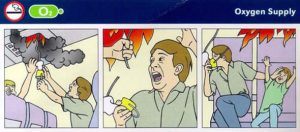
“Zozzantoz 2015-02-12 19:19:02
‘Put an oxygen mask on children and others only once your own has been put on.’ Are you crazy? […]
trizs77 2015-02-12 20:28:12
Reassure us. You weren’t top of the class in logic, right?”
trizs77, “Repülőszerencsétlenség” [plane crash], forum.index [Hungarian discussion forum] (Feb. 12, 2015)
“Why do airlines announce like this. It sounds funny and crazy right. For everything we say children first. But here, why do we put them as second.” Prakash Shankar, “Oxygen mask – Adult first and then children. Why?“ Cockpit Voice [blog] (Jul. 2, 2015)
“Share it far, share it wide. It’s a major red pill for women. Search ‘oxygen mask first’ and you’ll see lots of articles & mommy blog posts about ‘self care.'” Anonymous, Re: “What America First Means. Updated. Made child the world.” Deleted from r/The_Donald, Reddit; reposted on REBRN
“As a parent, the first time you hear the flight attendants tell you to put your emergency oxygen mask on before your children’s; you’re probably a little horrified. We’d all die for our kids—so how can we selfishly take care of ourselves before we attend to them? The answer is, because if you’re dead, you can’t take care of anyone, and conversely, if you can breathe, you can help everyone around you. We must put America first.” Committed Conservative, “America First: Let’s Secure Our Own Oxygen Mask” (Mar. 2, 2017)
“While on a flight to Washington last year, Defense Secretary James Mattis was pondering how to make President Donald Trump’s ‘America First’ foreign policy fit with the need for alliances. Inspiration came in an unexpected form: The flight attendant’s safety briefing about what to do in case the plane lost cabin pressure at altitude. […] [A] new metaphor to describe American foreign policy had just been born.” Jeff Schogol, “Mattis Uses In-Flight Safety Brief To Explain ‘America First’ To Allies,” Task and Purpose (Jan. 19, 2018)

“[Trump, struggling to decipher airline safety instructions]
‘Attend to your own oxygen mask first….as opposed to what?'” thegagster1, “#1497,” The Standup’s Daily Gag Feed [blog] (Sep. 9, 2017)
“There’s a reason we have to be reminded every time we fly that in the event of an emergency, we must start by securing the oxygen mask over our own mouth and nose, and only then over the child’s. There’s a reason slamming the brakes automatically makes us reach an arm out for our son or daughter in the passenger seat. We are wired to take care of those more vulnerable. This is what we do as humans. There’s a reason we took a collective gasp when we saw the photo of the bloodied and ash-covered face of a 5-year-old Syrian boy after an airstrike hit his family’s home in Aleppo, or the image of a 3-year-old Syrian boy whose drowned body had washed up on a Turkish beach, or even further back, the iconic photo of a 9-year-old Vietnamese girl, naked and terrified after her village was scorched with napalm. That wasn’t a Republican or Democratic or independent gasp—it was just a gasp, proof of our shared humanity.” Oscar Cásares, “A child doesn’t cry in Spanish or English. A child simply cries, and we respond.” Washington Post (Jun. 22, 2018)
“Images of dying children with oxygen masks strapped to their tiny faces made ‘a big impact’ on the US president. He was visibly shaken as he spoke about ‘beautiful little babies.’ It was almost as if Mr Trump had missed the first six years of the Syrian war and was only now tuning into its recurring horrors.” Carole Coleman, “‘America First’ approach has flopped – but uniting the world against brutality earns Trump respect he craves,” Irish Independent (Apr. 8, 2017)
“In the famous last words of Eric Garner, ‘I … can’t … breathe,’ there is a metaphor for the asphyxiation we are experiencing as black people in America and in Spokane. The air is thinner for us now; we are not all getting the same amount of oxygen here. So don’t stop us when we reach for the oxygen mask that is hope for justice. Let us say what we need to say, march when we need to march, and hold our kids when we need to feel their hearts beat. Let us be, be with us, and let us breathe.” Rachel Dolezal, “Let Us Breathe,” Inlander [commentary] (Dec. 10, 2014)
“Thanks to the work of WoC [women of color] particularly, across mental health and social work, across grassroots activism and civil rights, and across broader cultural conversations regarding the importance of ‘fixing your own oxygen mask, before attending to others,’—it’s now hard to see self-care as anything but a political act.” Jerico Mandybur, “Self Care 101: Where Did “Self-Care” Even Come From?” girlboss [blog] (Feb. 7, 2018)
“Black Lives Matter. We are in the 21st century and we STILL have to say it. If a plane is going to crash, you put your oxygen mask on first. The expectation for people of color… is for us to just be of service, to educate to help. Our resources are mined, stolen…appropriated while we are left with nothing. […] My mission…the people who need my nurturing and compassion…are my fellow African Americans.” Ashe/J9, “Oxygen Masks…Cutting cords,” visAbleblackwoman [blog] (Aug. 20, 2017)
“‘Unity for all’ comes after you make sure you have Unity for you and yours. Like on a crashing airplane – put on your oxygen mask first – before you try to save someone else.” DeDe79, Re: sade, “Ann Coulter on Black Preacher Show says Civil rights are for Black Americans only gets boo’ed by Blacks,” Lipstick Alley [forum] (Aug. 20, 2016)
“Anonymous (ID: hKDkqWFw) 03/07/18(Wed)02:18:57 No. 163016583
When you fly in the airplane, they tell you to put on your own oxygen mask FIRST before you help your child with their mask. It sounds so CRUEL but it’s a great analogy on what is going on with immigration. Right, so you bring in these immigrants that don’t even know WHAT THE FUCK SOCIETY IS, much less a Nuclear Family. They are uncivilized. You cannot integrate these people in such huge numbers. And simply handing out Welfare to the new immigrants brings on a MASSIVE amount of animosity from White Men like myself who wind up footing the bill. Now I fucking hate everybody. I hate women for voting for this mess. I hate most blacks for soaking up my tax dollars. Now I won’t participate in society. I’ve gone MGTOW [Men Going Their Own Way]. I refuse to pay taxes so I work under the tax bracket….just enough for my Vidya; computer; pizza; beer and a comfy bed. This, my friends, is how a society collapses.” hKDkqWFw, Re: 9LwB5h4j, “Racism,” /pol/, yuki.la [4chan archive]
“I’ve learned the hard way that no matter how much you might love something, it can still wear on you and you have to learn self-care, you have to put yourself first. That’s not selfishness. That’s self-preservation. I call it ‘oxygen mask theory.’ […] In America we are so fast-paced, goal-oriented, achievement-driven. That’s why our nation is so powerful in this world, but I feel like it’s also why we suffer so many illnesses.” Lisa B. Shaffer, “Oxygen Mask Theory,” Center for Trauma and Abuse [blog] (Mar. 6, 2017)
“I am sure that some of you reading this are doctors. […] You can work towards the dream of everyone dying peacefully in their sleep at age 99 or more, but once you have done all you reasonably can, then it is time to stand back and let go. […] The key word here is reasonably. Because we don’t want to be reasonable. Our hearts and passion are engaged. We want to do everything possible (and indeed impossible) to right wrongs, to heal, to restore. Reasonable does not come into it. So we expend ourselves totally and leave nothing. […] But, just as we are instructed in the safety talk on aeroplanes, we need to put on our own oxygen mask first before we assist others. […] We need to comfort ourselves first. When it’s time to let go, we need to let go.” Mary Wednesday, “Put on Your Own Oxygen Mask First,” Moodscope [blog] (Jan. 25, 2017)
“As exclusion of oxygen extinguishes a fire, so, too, in a man or animal a deficiency of oxygen in the blood and tissues induces death. There are many modes of dying, but there is only one final common cause of death. Whether the brain is destroyed, the lungs blocked, or the heart stopped, death finally occurs in but one way only […] the supply of oxygen ceases. Unless a man is burned alive, the tissues of his body always die of anoxia.” Bruce L. Douglas, “The Complications of General Anesthesia in Dentistry as Related to the Respiratory System,” Oral Surgery, Oral Medicine, Oral Pathology (Feb. 1954)
“Among the various exploits, vital or destructive, which oxygen can perform, we varnish makers are interested above all in its capacity to react with certain small molecules such as those of certain oils, and of creating links between them, transforming them […]” Primo Levi, The Periodic Table (1975)
***
NOTE: Bracketed ellipses represent our own cuts; regular ellipses are the original authors’.
